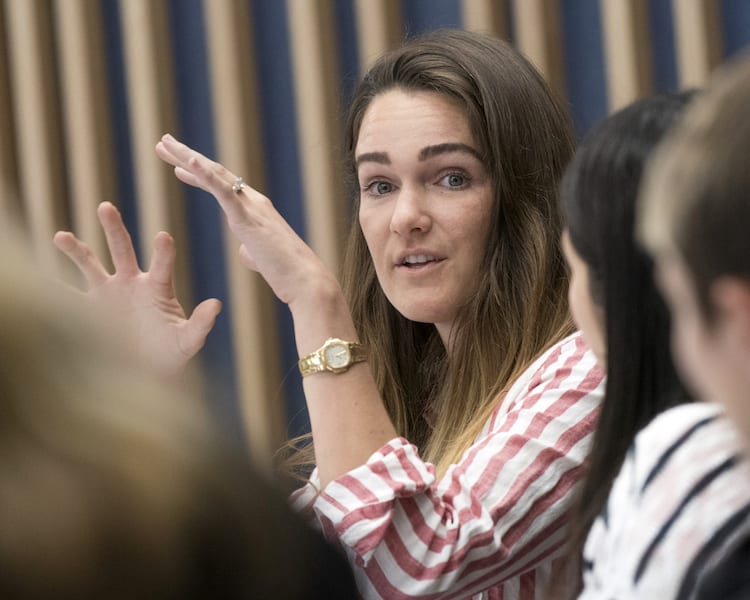“Classified” is an occasional series spotlighting some of the more powerful lessons being taught in classrooms around Haas.

Class discussions about sex trafficking, crash test dummies designed to match male—but not female—physiology, and the challenges a breast pump company faced in attracting venture capital were unsettling.
But it wasn’t until the conversation turned to the relatively mundane acts of sexism women encounter daily—such as unwanted advances at business dinners—that Federico Locatelli, MBA 18, spoke up.
“I didn’t really understand before what women have to deal with,” said Locatelli, one of the ten men in Kellie McElhaney’s class “The Business Case for Investing in Women.” “It’s been completely mind-blowing.”
For McElhaney, an associate adjunct professor who created the course four years ago, Locatelli’s discomfort isn’t a reason to stop the conversation, but rather a justification to blow it wide open.
“This is about pushing people out of their comfort zones so that they can then become leaders who can handle uncomfortable discussions later on,” McElhaney said.

Building a case
The idea for an MBA course focused on gender equity first came to McElhaney about a decade ago while she was serving as director of the Center for Responsible Business at Haas. McElhaney had uncovered a correlation between Fortune 500 companies’ performance on a closely-watched sustainability index and the presence of women directors on its board. That data point alone suggested there was a business case—not just an ethical one—for gender diversity in the workplace.
 Over the next few years, as the cultural conversation around women at work gathered momentum, companies started asking McElhaney for more proof of a bottom-line payoff to hiring women.
Over the next few years, as the cultural conversation around women at work gathered momentum, companies started asking McElhaney for more proof of a bottom-line payoff to hiring women.
Students, too, wanted to see data. “In a very constructive way, students would say, ‘Show me the proof that gender equity really matters to a company’s overall success.’”
So, McElhaney gathered statistics which suggested companies with greater numbers of women in leadership have higher share prices and better returns on equity and investment than companies with fewer women. She cites companies like Patagonia, which has publicly detailed how its on-site childcare nearly pays for itself.
When McElhaney started the course in 2013, she structured it almost entirely around the data. The class proved so popular that students awarded her an Earl F. Cheit Award for Excellence in Teaching. Next month, McElhaney is also launching the Center on Gender, Equity & Leadership to take her work to the next level.
“Kellie is a firecracker—passionate, smart, challenging, and funny,” says Jennifer Hoss, MBA 18. “She takes a very pragmatic approach of ‘nobody is asking for any favors.’ At the same time, this class is a great exercise in empathy.”
Hoss said she enjoyed seeing the diversity of opinions, even among women. “You realize that each person experiences gender issues in a different way. We have 30 different women and 30 different viewpoints on how wrong or not-wrong a situation is,” she said.
Exploring intersectionality
The course also delves into the added challenges that minority women encounter. McElhaney shared a breakdown of data showing that white women are making most of the workplace gains while minority groups either are flat-lining or losing ground.
Victoria Whittaker, MBA 18, who is African-American and Latina, said that when it comes to gender, race, and sexuality, “we tend to separate the issues.”
Shedding light on the intersectionality of an issue like gender helps raise awareness that there can many different experiences and perceptions that influence people’s world views, she said. “As business leaders and managers, it’s imperative that we start to recognize, think about, and appreciate all the different facets people bring when they walk into the workplace,” she said.
Are diversity and inclusion valued?
Many of McElhaney’s students, including Locatelli, are intent on using their newfound awareness to advocate for women. “Students—and this is also true for the companies I talk to—understand the data,” McElhaney said. “Now they want tools to create change.”
One assignment McElhaney gives students is to write formal assessments of a company’s track record on the hiring, retention, and promotion of women. The head of global HR at Airbnb was so impressed with a student presentation—which McElhaney sent unsolicited—that she asked the students to speak to company executives about it.
Students also discuss real-life workplace issues with guest speakers.
In October, a speaker admitted how shocked he was when a valued female executive at his company disclosed in her exit interview that she didn’t feel as though diversity and inclusion were valued. Looking to uncover insights like these sooner, he instituted “stay” interviews for current employees.
Designing a personal leadership strategy
McElhaney also challenges students to consider their own experiences with gender discrimination or harassment, including how they’ve responded to past incidents and how they could have reacted differently. For a session that delved into how men impact gender issues, students were required to bring a male friend to observe the class.
Finally, students create a detailed personal leadership strategy.
“You’re at Haas to learn about business strategy,” McElhaney tells students. “You’re also here to learn leadership skills. So, how are you going to build gender awareness into your leadership style?”
Lydia Cole, EWMBA 18, came to the class looking for facts and figures to help her self-advocate in her career. She’s learned instead that proof of women’s value in the workplace won’t be as important as her ability to lead by example.
“My attitude before was cynical,” said Cole. “Kellie’s class has taught me how to be a better employee, a better manager, a better leader, and a better person.”

